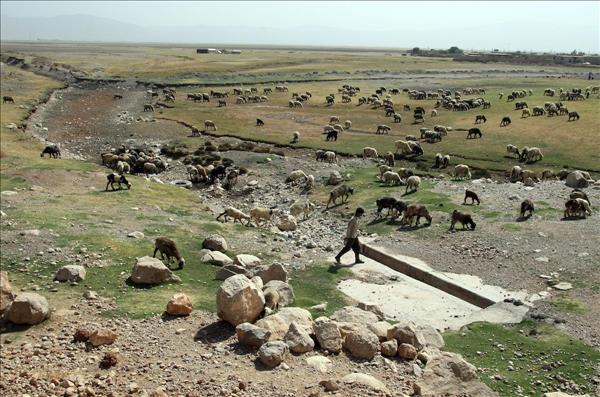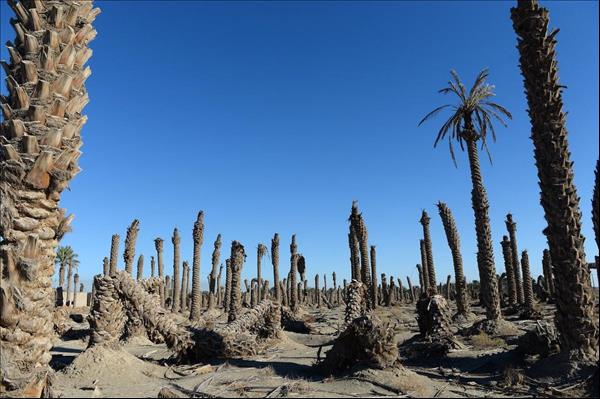(MENAFN- Asia Times) When facing down public dissent and unrest, Iranian authorities are known to downplay the magnitude of the various crises they confront. But officials are uncharacteristically sounding the alarm about a mounting water crisis, one which could trigger a full-blown conflict over access to the essential resource.
According to Minister of energy Reza Ardakanian, the coming summer in the Iranian calendar year will be the ''driest in the recent five decades.'' The minister said he was concerned about peaking demand for drinking water and cast doubt on the government's ability to ensure an uninterrupted supply of water nationally.
Iran is now confronting its most severe drought in half a century, with climate change contributing to a staggering drop in rainfall relative to preceding years. Authorities have been unable to remedy the impact of the record dry spell, though they are speaking up about the existential risks posed by the looming water crisis.
Isa Kalantari, the head of the Department of Environment, scrubbed political correctness when he declared on May 17 that ''Iran is being wiped off'' due to the meteoric dilution of water resources. He shocked Iranians with warnings that the ''water war'' was quickly extending from one province to another, spilling over into villages.
The pro-reform politician who, unlike most high-ranking officials of the Islamic Republic, doesn''t mince words when talking publicly about the country's challenges, said that in line with the consensus at the 1992 Rio de Janeiro Earth Summit, countries were urged to utilize only 40% of their renewable water resources.
But Iran has for years been making use of more than 100% of its renewable reserves. ''We, the officials of the past 40 years, should be held accountable to history regarding the decisions we made at the high levels resulting in the environmental destruction of the country,'' said Kalantari at a recent webinar.

An Iranian shepherd from the Qashqai tribe grazes his sheep near a dried-up river in Eghlid in the southern Iranian province of Fars. Photo: AFP / Atta Kenare
Poorly built dams
The Iran Meteorological Organization estimated that rainfall in southern Sistan and Baluchestan provinces has been 82% lower than the long-term average, while Hormozgan province, bordering the Persian Gulf and the Gulf of Oman, had received 86% less rainfall than the region's dominant pattern.
Iran has invested heavily in the construction of dams throughout the country, which experts say play a negative environmental role in evaporating renewable water reserves and are mostly poorly built.
The reservoir capacity of the country's dams has plummeted by 10 billion cubic meters (BCM) since last year, standing at 29.5 billion cubic meters as of the current discharge year.
Unbridled extraction of water from dams in the past decades has caused a loss of reserves totaling 130 billion cubic meters, and the water balance of aquifers is also presently negative.
This depletion, in addition to leaving the government hard-pressed to supply drinking water to less-developed regions, remote cities and villages, has made agricultural self-sufficiency very difficult.
Agribusiness consumes 92% of Iran's renewable water resources, much higher than the global average of 70%. With the perturbing trend of rainfall decline spurring an at times violent national competition for access to dwindling water supplies, farmers are exhausting all options to preserve their crops – including by building illegal wells.
Farmers are said to be illicitly withdrawing 4.7 billion cubic meters of water every year by digging their own wells or installing water pumps, a stumbling block in the way of ambitious government plans to truncate the total withdrawal from ground wells by 11 billion cubic meters.
Some scholars blame the inefficiency of Iran's irrigation systems for upending the demand and supply cycles for agriculture and industries.
''Around 80-90% of the country's water is used in the agricultural sector. But the irrigation systems are still mostly traditional with very low efficiency. Despite all the investments, the adoption of high-efficiency irrigation systems, particularly in smaller farms, has been very slow,'' said Saman Razavi, an associate professor at the University of Saskatchewan's School of Environment and Sustainability.
''Moreover, some water-demanding industries are located in water-scarce regions of the country due to geopolitical considerations, which puts more pressure on water resources. Of course, you need to bring population growth into the equation as well. Needless to say, this water balance equation does not hold,'' Razavi added.
''Therefore, Iran has needed to tap into deep groundwater resources, that are commonly known to not be renewable at short time scales.''
The mélange of climate change and maladministration responsible for stoking the unprecedented water crisis isn''t only impinging on the agriculture sector.
Access to clean drinking water is not readily available to many ordinary Iranians, and experts warn that Iran should expect increased rural migration to cities with more developed water treatment facilities in the years to come.
Ghasem Taghizadeh Khamesi, Iran's deputy minister of energy, claimed last year in an interview that nearly 10 million Iranians lack sustainable water access. He noted that there were 6,000 villages dotted across the country which totally lacked efficient water supply facilities, and are only able to supply residents with limited quantities using tankers.
In a 2018 interview, environment department chief Kalantari claimed if the current levels of water consumption for agricultural use remain unchanged, Iran's populous southern and eastern regions will be entirely vacated in less than 25 years.

Date palm trees are seen as one of Iran's major sources of income, but the drought in Kerman province has taken a toll. Photo: AFP / Fatemeh Bahrami / Anadolu Agency
''If we do not find a solution for the water crisis, some 50 million Iranians will immigrate from the country. Perhaps an entity named Iran will be non-existent,'' he said.
Ali Nazemi, an associate professor at the Department of Building, Civil and Environmental Engineering at Concordia University, told Asia Times he agrees with the energy department chief's assessment, but lamented how Iranian politicians have put dealing with the water dilemma on the backburner.
''Kalantari is completely right … and definitely, something needs to be done,'' he said. ''However, I don''t think the water crisis is still a top priority. In the [current] presidential election campaign, I''m not seeing any of the candidates making any points about the environment. Nobody talks about the environment, and that is quite frightening for a country like Iran,'' he added.
Compounding the unfolding water calamity is the fact that the strategically imperative bodies of water that border the country – the Caspian Sea, Persian Gulf, and Gulf of Oman – cannot be considered as auxiliary to the procurement of drinking water unless expensive desalination plants are launched, which experts say is not a viable option for Iran.
''Bordering saltwater is not giving you a competitive advantage in terms of freshwater supply. Essentially, the problem in Iran is that it has overused its freshwater supplies,'' said Kaveh Madani, a noted environmental scientist and the Henry Hart Rice Senior Fellow at Yale University's MacMillan Center for International and Area Studies.
''The amount of water use has surpassed the renewable water reserves long ago, which is a situation I refer to as water bankruptcy.''
Deadly water conflicts
On the prospects of the eruption of deadly water conflicts in Iran, Madani, who is also a visiting professor at the Imperial College London, says these tensions are already underway and taking their toll.
''We have seen conflicts in Iran over water transfer or the implementation of water infrastructure. We''ve had conflicts in central Iran, including in the provinces of Isfahan, Chaharmahal and Bakhtiari and Khuzestan. We have had cases of strikes, tensions and even people getting killed,'' he told Asia Times.
''Further water shortage and problems with the unfair allocation of water resources can trigger more tensions. But we in the water world are mostly afraid of mass migration in search of jobs and better livelihoods, marginalization of communities, inequalities and the follow-up tensions … seen in other parts of the world,'' Madani added.
Despite all the blunders Iran has made in the management of its natural resources, scientists believe there are steps that can be taken to avert an environmental cataclysm.
''The country can only handle this crisis with a paradigm shift from exploiting existing water resources to dramatic water conservation and using available water sustainably,'' said Mohammad Reza Najafi, an assistant professor of hydrology and water resources at the University of Western Ontario.
The Canada-based academic recommends that Iran capitalizes on the Managed Aquifer Recharge (MAR) adaptation measure and Sustainable Drainage Systems (SuDS) approach to tamp down its vulnerability to climate change and regulate moderation in consumption.
Experts, however, agree that the Iranian government isn''t doing enough to address its water insolvency crisis. Far from acknowledging the need for a paradigm shift in the country's management of the resource, Tehran has sidelined scientists with the know-how to help politicians devise robust policies to shore up the country's environmental resilience.
''Solving Iran's water and environmental problems requires a full-scale governmental focus that incorporates scientists'' views. Oftentimes, however, scientists have been alienated to serve short-sighted policies,'' said Mojtaba Sadegh, an assistant professor at the Boise State University researching climate change.
''Furthermore, Iran is engaged in several full-fledged crises such as global relations and sanctions which push the water and environmental problems to lower priorities,'' the academic added. ''I hope that Iran advances toward a more sustainable use of water. The current trends don''t seem too promising, though.''
MENAFN27052021000159011032ID1102150847